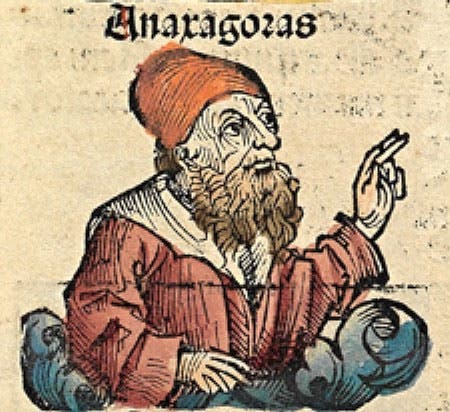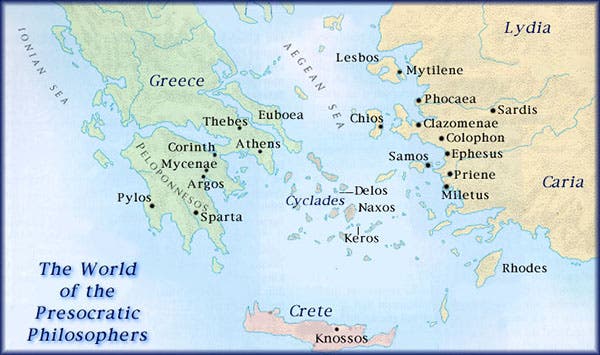Scientist of the Day - Anaxagoras of Clazomenae
Anaxagoras of Clazomenae, a Presocratic natural philosopher, lived from about 510 BCE to around 430 BCE, so he was philosophizing about 40 years earlier than Socrates and 80 years before Plato. Clazomenae was a city in the region known as Ionia, on the modern-day coast of Asia Minor, and was a member of the Ionian League, but Anaxagoras is not usually referred to as an Ionian philosopher, lest he be confused with Thales, Anaximander, and Anaximenes of Miletus, and Heraclitus of Ephesus, whose natural philosophy was quite different.
Anaxagoras lived about the time that Parmenides of Elea called into question the basic assumption of the earlier Ionians, that the multiplicity of the world had proceeded from a single primordial substance as a result of natural processes. Parmenides countered that if that were the case, then the only entities in the universe would be Being and Non-Being, which meant Being could never change, since there was nothing but non-Being to act on it or mix with it. Change was an illusion, so Parmenides argued, and his disciple Zeno drove home that point with his paradoxes.
Anaxagoras sidestepped the Eleatic challenge by going to the other extreme from Thales and postulating that for every property in the larger world, there exist tiny elemental particles – “seeds" – with that property. There are as many kinds of basic matter as there are properties in the cosmos. Anaxagoras found that with that assumption, he could explain such difficult matters as the problem of growth. How does an organism eat wheat and turn it into bone and flesh? That is easier to explain if the seeds of bone and flesh were already in the wheat to begin with; growth then was merely the extraction and compilation of the right seeds. The idea that the world has been fashioned from an infinite variety of basic seeds is initially quite unsatisfying, but when you think about it, it rather grows on you, as an ingenious solution to a difficult conundrum, the source of change.
In our first post on a Presocratic, Thales of Miletus, we introduced a slim book called Ancilla to the Pre-Socratic Philosophers (1971), a translation by Kathleen Freeman of every preserved fragment attributed to a Presocratic philosopher, of which there were more than 90. Since the book is only 162 pages long, we used it to make the point that we do not have much original source material to go on when we talk about early Greek natural philosophy. The entry for Thales, for example, is empty, and Anaximander and Anaximines do not fare much better. If we turn to Anaxagoras, we find that there are 24 fragments (fragment 21 is actually 3 fragments), which fit nicely onto four octavo pages of Freeman’s book. This is enough, however, to understand Anaxagoras’s basic approach. I thought I would quote several of the fragments here (or parts of them):
4. Conditions being thus, one must believe that there are many things in all sorts of composite products, and the seeds of all Things, which contain all kinds of shapes and colours and pleasant savours.
6. And since there are equal parts of Great and Small, so too similarly in everything there must be everything. It is not possible (for them) to exist apart, but all things contain a portion of everything.
12. Other things all contain a part of everything, but Mind [Nous] is infinite and self-ruling, and is mixed with no Thing, but is alone by itself.
21a. Visible existences are a sight of the unseen.
The last fragment is especially interesting, since it suggests that our senses are reliable enough to infer, from what we see, that which we cannot see. And the next-to-last is also intriguing, as Anaxagoras introduces the idea of a cosmic mind [Nous], which is not material, and which brings order to the seeds and to the world and keeps chaos at bay.
Anaxagoras of Clazomenae was the first (in our order of discussion) of what would come to be called Pluralists, natural philosophers who postulated the existence of more than one basic cosmic substance. Other pluralists, such as Empedocles and Democritus, would have other solutions to the Eleatic challenge, which we will discuss in due course. All would have an impact on Aristotle as he put together his theory of matter, 100 years later.
As with all the Presocratics, there is little in the way of imagery to brighten our page. The portrait of Anaxagoras in the Nuremberg Chronicles certainly does not present the features of the real Anaxagoras, but it will have to do. And perhaps a map of ancient Greece, with the location of Clazomenae marked, just north of Ephesus and Miletus in Ionia, will be of some aid. We could show you a view of Athens, since Anaxagoras was the first Presocratic to move there, to tutor Pericles, but that would seem to violate some Presocratic Oath. We should make Athens wait its turn.
William B. Ashworth, Jr., Consultant for the History of Science, Linda Hall Library and Associate Professor emeritus, Department of History, University of Missouri-Kansas City. Comments or corrections are welcome; please direct to ashworthw@umkc.edu.






![Using an astrolabe to measure the depth of a well, woodcut in Elucidatio fabricae vsusq[ue] astrolabii, by Johannes Stöffler, 1513 (Linda Hall Library)](https://assets-us-01.kc-usercontent.com:443/9dd25524-761a-000d-d79f-86a5086d4774/a998eb50-55d2-4a88-ace2-a50aa5fa86e7/Stoffler%201.jpg?w=210&h=210&auto=format&fit=crop)

